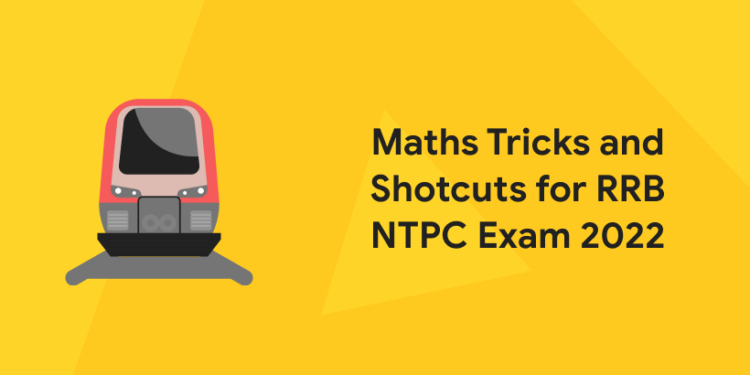Table of Contents
Non-Technical Popular Categories is the full form of NTPC. The Railway Recruitment Board (RRB) conducts the RRB NTPC test to select candidates for different non-technical positions in the Indian Railways. RRB NTPC positions are open to applicants who have finished their degree or passed class XII. The RRB NTPC 2022 test has four stages: CBT 1, CBT 2, Typing Skill Test/Computer Based Aptitude Test (where applicable), and Document Verification. The following are the highlights of the RRB NTPC 2022 exam:
| Topic | Particulars |
| Full-Form of NTPC | Non-Technical Popular Categories |
| Name of the exam Organising body | Railway Recruitment Board (RRB) |
| Level of exam | National |
| Mode of Applying for the exam | Online |
| Application Fees | · General Category– INR 500
· SC/ST/Ex-serviceman/Women/Minorities/Physically handicapped candidates – INR 250 |
| Mode of Exam | Offline (CBT) |
| Duration of exam | 2 Hours |
| Category of posts |
|
| Phases of Exam or Selection Process |
|
| Medium or Languages of Exam | 15 Languages |
| Official Website | https://indianrailways.gov.in/ |
Click here to know about important events and dates of the RRB NTPC Exam 2022
RRB NTPC Exam Pattern 2022
The steps of the RRB NTPC recruiting procedure are as follows:
- CBT 1
- CBT 2
- Skill Test/ Aptitude Test
- Document Verification Process
- Medical Examination
Click here to learn about trends in numerical ability questions of the RRB NTPC Exam
RRB NTPC Exam Pattern 2022: CBT-1
- The authorities administer a first-stage computer-based test (CBT) to screen candidates.
- The exam will take 1.5 hours to complete (90 minutes). The PWD applicants will get 120 minutes to complete the test.
- For each incorrectly attempted question, 0.25 marks are deducted.
- If a question is left unanswered, no points are removed.
The test has the following number of parts and questions per section:
| Sections | Number of Questions | Total Marks |
| Mathematics | 30 | 30 |
| General Intelligence and Reasoning | 30 | 30 |
| General awareness | 40 | 40 |
| Total | 100 | 100 |
Register to get a free mock test package for Maths for RRB NTPC Exam 2022
RRB NTPC Exam Pattern 2022: CBT-2
- The RRB NTPC CBT-1 normalised score will be used to select applicants for the 2nd Stage CBT based on merit.
- The level of complexity of the test questions varies according to the post levels.
- The exam will take 1.5 hours to complete (90 minutes).
- Negative marking is used, with each incorrect response deducting 1/3 of the total marks allocated to the question.
The RRB NTPC Exam pattern 2022 for Computer-based test-2 is as given below.
| Sections | Number of Questions | Total Marks |
| Mathematics | 35 | 35 |
| General Intelligence and Reasoning | 35 | 35 |
| General awareness | 50 | 50 |
| Total | 120 | 120 |
Register to get access to video lectures for Maths for RRB NTPC Exam 2022
RRB NTPC Exam Syllabus 2022 for Mathematics
1: The electron was discovered by________.
- Elementary Algebra
- Profit and Loss
- Mensuration
- LCM
- Time and Work
- Ratio and Proportions
- HCF
- Number system
- Fractions
- Simple and Compound Interest
- Trigonometry
- Elementary Statistics
- Time and Distance
- Geometry
- Decimals
Register to get the latest study materials for RRB NTPC Exam 2022 geometry section
Maths Tricks and Shortcuts for RRB NTPC Exam 2022
Shortcut tricks for maths are essential for the effective completion of the Quantitative aptitude and reasoning section within the given time limit. Direct methods are often lengthy and consume the precious allotted time which leads the candidate to not get sufficient time even to read all the questions let alone attend to them and mark the answers. Shortcut tricks for math is an essential knowledge one has to master if one plans to win state level and nationwide competitive examinations. A few such tricks are discussed in the paragraphs given below.
Shortcut Tricks for Maths 1: Finding the Square Root
Estimating and multiplying to find the square root of a number can be a time-consuming process. A simpler approach for finding the square root of an integer is as follows:
- Find the square root of 2116 as an example.
- To determine the square root of 2116, use the following formula:
- Step 1: Look at the digit at one’s place. It is 6 in this scenario. Check between 1 and 9, the square of which all integers have “6” at their one’s places. 4 and 6 are the correct answers.
- Step 2: Now find the square of the number between 1 and 9 that is closest to the provided number’s first two digits. Which number between 1 and 9 comes closest to 21 in this case? The numbers are 4 and 5 whose squares are 16 and 25 respectively.
- So, the square root of 2116 is one of the numbers 44, 46, 54, and 56.
- Multiply each of the two numbers you received in step 2 by the next number in the number series. That is, 4×5 = 20 and 5×6 = 30. Because 20 is a number that is closer to 21, either 46 or 44 must be the answer. Multiply your answer and double-check it.
Click here to get illustrated examples and sample questions for the Squares and square roots section
Shortcut Tricks for Maths 2: Finding the Cube Root
To easily get the cube root of an integer, use the procedures shown below. What is the cube root of 9261, for example?
- Step 1: Find the integers from 1 to 9 whose cube equals the digit at the one’s position, in this case, 1. As a result, we obtain1×1×1 = 1
- Step 2: Look at the number’s initial digit, which in this case is 9. The number 9 falls between the cubes of 2 (2×2×2=8) and 3 (3×3×3 = 27). Because 8 is the closest number to 9. 9261 has a cube root of 21.
- Use the first two digits instead of the first digit in step 2 to calculate the cube root of a five-digit number.
Click here to get illustrated examples and sample questions for the cubes and cube roots section
Shortcut Tricks for Maths 3: Quadratic Equations
Here are two instances of quadratic equations that can be solved rapidly using simple tricks:
- take x² – 18x + 45 = 0 as an example
- Step 1: Multiply the x² coefficient with the equation’s constant. 1×45 = 45 in this situation.
- Step 2: Multiply the coefficient of x by “-1.” -1× (-18) = 18 in this situation.
- Step 3: As a result, x will have the values 15 and 3 (3+15=18 & 3×15=45). Remember that if you get a positive answer in both steps 1 and 2, both values of x will be positive. If even one of the variables is negative, then the values of x will also be negative.
- Because the result of steps 1 and 2 is positive, the value of x will also be positive. As a result, the solution is x = 15, 3
Click here to get illustrated examples and sample questions for the Quadratic Equations section
Shortcut Tricks for Maths 4: Compound Interest
Here are a few formulae that will help you save time on the test while addressing compound interest problems:
- If the first interval of time has a compound interest of x per cent and the second interval of time has a compound interest of y per cent, then after the two periods, the net effective rate of interest is x + y + (xy/100). Note that this only applies if both periods are equal.
- If a sum of money, suppose P, at Compound Interest amounts to A1 in a given length of time, suppose T, and the same sum of money at Compound Interest amounts to A2 at “2T” time, then, A1/A2 = P/A1.
- If a sum of money, suppose P, accumulates A1 over a period of time, suppose T, at compound interest, and then accumulates A2 after T+1 years at compound interest, then, (A2-A1) / A1 100 = Rate of Interest.
Shortcut Tricks for Maths 5: Simple Interest
Use the formulae below to save time on the quantitative section of the final exam by using them to solve the questions:
- For two years, the difference between simple and compound interest = {(PR)2/ (100)2}.
- For three years, the difference between simple and compound interest = {PR2 (300+R) / 1003}
Click here to learn more shortcuts to solve simple and compound interest questions
The aforementioned math shortcuts and strategies will only be beneficial if a candidate has solid foundations in math. Moving forward might be difficult if the foundation is unstable. So, for a better result, applicants must devote adequate time to each topic and ensure that the fundamentals are understood, as only then will they be able to choose which mathematical techniques to use where. Not only should one memorise the formulae, but one should also grasp how to use them so that you may save time while answering questions from other areas. Before beginning to answer a question, read it and make sure you understand it, then start answering it using the simplest and quickest method possible to avoid wasting time. Create tables and charts to simplify the provided data if the question is lengthy and solving it takes a long time. Many candidates spend time solely on a single question in particular. Unknowingly, a candidate wastes valuable time that could be used to answer other questions.
Maths Tricks and Shortcuts for RRB NTPC Exam 2022 provided above will assist individuals in preparing for forthcoming competitive tests and in scoring higher in this segment in particular. Download the Entri app to get more Maths Tricks and Shortcuts for RRB NTPC Exam 2022 for QA topics like number series, allegation, time and work etc.










